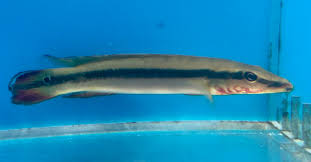Midwest Aquarium and Pond Supplier LLC
(197) Red Pike Cichlid
(197) Red Pike Cichlid
Precio habitual
$69.97 USD
Precio habitual
Precio de oferta
$69.97 USD
Los gastos de envío se calculan en la pantalla de pago.
Cantidad
No se pudo cargar la disponibilidad de retiro
The Red Atabapo Pike Cichlid (Crenicichla sp. 'Atabapo I') is a highly prized, large, and extremely aggressive freshwater predatory fish known for its intense blood-red coloration as an adult. Originating from the blackwater Atabapo River system in South America, this species is best suited for experienced aquarists due to its specific care requirements and temperament.
Key Characteristics
- Scientific Name: Crenicichla sp. 'Atabapo I'
- Common Names: Fire Red Atabapo Pike, Atabapo Pike Cichlid
- Adult Size: Typically reaches 12-14 inches (30-35 cm), with some reports of up to 16 inches.
- Coloration: Juveniles are a light yellow with a black stripe, but they develop a vibrant blood-red body and distinctive red blotches on the gill covers as they mature.
- Temperament: Notoriously aggressive and territorial, making them challenging to house with other fish. They are best kept in a species-only tank or with very large, robust, and similarly tempered tank mates.
Habitat and Tank Requirements
To ensure the well-being of a Red Atabapo Pike Cichlid, it is crucial to mimic their natural blackwater environment.
- Tank Size: A minimum of 125-180 gallons is recommended for a single adult, with a wide footprint being more important than height.
-
Water Conditions: They thrive in soft, acidic water.
- Temperature: 76–82°F (24–28°C)
- pH: 5.5–7.0
- Hardness: Soft to moderately hard
- Decor: The aquarium should be furnished with plenty of hiding spots and visual barriers to reduce aggression. This can include tangles of driftwood, rocky caves, and PVC pipes, with a sand substrate preferred as they like to dig. Strong filtration is essential to maintain water quality.
Diet
The Red Atabapo Pike Cichlid is a carnivore and an ambush predator in the wild.
- They should be fed a varied diet of high-quality, high-protein foods.
- Suitable options include frozen shrimp, fish, krill, and high-quality cichlid pellets.
- Occasionally providing live prey can stimulate their natural hunting behavior.
Share
No reviews

